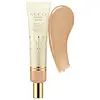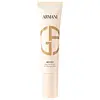Gucci Glow Skin Tinted Moisturizer With Hyaluronic Acid & Bakuchiol Versus Armani Beauty Skin Tint Longwear & Care
What's inside
What's inside
 Key Ingredients
Key Ingredients

 Benefits
Benefits

 Concerns
Concerns

 Ingredients Side-by-side
Ingredients Side-by-side

Water
Skin ConditioningDimethicone
EmollientGlycerin
HumectantPolyglyceryl-3 Diisostearate
EmulsifyingDiphenyl Dimethicone
EmollientEthylhexyl Palmitate
EmollientHydrogenated Lecithin
EmulsifyingPotassium Cetyl Phosphate
EmulsifyingPropanediol
SolventHydroxyacetophenone
AntioxidantHydroxyethyl Acrylate/Sodium Acryloyldimethyl Taurate Copolymer
Emulsion StabilisingCaprylyl Glycol
EmollientEthylhexylglycerin
Skin ConditioningSodium Stearoyl Glutamate
CleansingMica
Cosmetic ColorantXanthan Gum
EmulsifyingTocopheryl Acetate
AntioxidantPhytic Acid
Sodium Hydroxide
BufferingBakuchiol
AntimicrobialSodium Hyaluronate
HumectantPolysorbate 60
EmulsifyingSorbitan Isostearate
EmulsifyingMethylpropanediol
SolventGlycyrrhiza Glabra Root Extract
BleachingTin Oxide
AbrasiveHyaluronic Acid
HumectantSilanetriol
Citric Acid
BufferingCI 77891
Cosmetic ColorantIron Oxides
CI 77163
Cosmetic ColorantWater, Dimethicone, Glycerin, Polyglyceryl-3 Diisostearate, Diphenyl Dimethicone, Ethylhexyl Palmitate, Hydrogenated Lecithin, Potassium Cetyl Phosphate, Propanediol, Hydroxyacetophenone, Hydroxyethyl Acrylate/Sodium Acryloyldimethyl Taurate Copolymer, Caprylyl Glycol, Ethylhexylglycerin, Sodium Stearoyl Glutamate, Mica, Xanthan Gum, Tocopheryl Acetate, Phytic Acid, Sodium Hydroxide, Bakuchiol, Sodium Hyaluronate, Polysorbate 60, Sorbitan Isostearate, Methylpropanediol, Glycyrrhiza Glabra Root Extract, Tin Oxide, Hyaluronic Acid, Silanetriol, Citric Acid, CI 77891, Iron Oxides, CI 77163
Isododecane
EmollientDimethicone
EmollientWater
Skin ConditioningGlycerin
HumectantAlcohol Denat.
AntimicrobialButylene Glycol
HumectantTrimethylsiloxysilicate
EmollientPEG-10 Dimethicone
Skin ConditioningPerlite
AbsorbentSilica
AbrasivePolyglyceryl-10 Laurate
Skin ConditioningSodium Hyaluronate
HumectantIsopropyl Lauroyl Sarcosinate
Skin ConditioningDiisopropyl Sebacate
EmollientDisteardimonium Hectorite
StabilisingBis-PEG/PPG-14/14 Dimethicone
EmollientMagnesium Sulfate
Synthetic Fluorphlogopite
Phenoxyethanol
PreservativeCalcium Aluminum Borosilicate
Ethylhexyl Hydroxystearate
EmollientDipentaerythrityl Tetrahydroxystearate/Tetraisostearate
Skin ConditioningParfum
MaskingAscorbyl Glucoside
AntioxidantSilica Silylate
EmollientDisodium Stearoyl Glutamate
CleansingNiacinamide
SmoothingAluminum Hydroxide
EmollientSodium Hydroxide
BufferingTin Oxide
AbrasiveKaolin
AbrasivePancratium Maritimum Extract
BleachingPentaerythrityl Tetra-Di-T-Butyl Hydroxyhydrocinnamate
AntioxidantIsododecane, Dimethicone, Water, Glycerin, Alcohol Denat., Butylene Glycol, Trimethylsiloxysilicate, PEG-10 Dimethicone, Perlite, Silica, Polyglyceryl-10 Laurate, Sodium Hyaluronate, Isopropyl Lauroyl Sarcosinate, Diisopropyl Sebacate, Disteardimonium Hectorite, Bis-PEG/PPG-14/14 Dimethicone, Magnesium Sulfate, Synthetic Fluorphlogopite, Phenoxyethanol, Calcium Aluminum Borosilicate, Ethylhexyl Hydroxystearate, Dipentaerythrityl Tetrahydroxystearate/Tetraisostearate, Parfum, Ascorbyl Glucoside, Silica Silylate, Disodium Stearoyl Glutamate, Niacinamide, Aluminum Hydroxide, Sodium Hydroxide, Tin Oxide, Kaolin, Pancratium Maritimum Extract, Pentaerythrityl Tetra-Di-T-Butyl Hydroxyhydrocinnamate
 Reviews
Reviews

Ingredients Explained
These ingredients are found in both products.
Ingredients higher up in an ingredient list are typically present in a larger amount.
Dimethicone is a type of synthetic silicone created from natural materials such as quartz.
What it does:
Dimethicone comes in different viscosities:
Depending on the viscosity, dimethicone has different properties.
Ingredients lists don't always show which type is used, so we recommend reaching out to the brand if you have questions about the viscosity.
This ingredient is unlikely to cause irritation because it does not get absorbed into skin. However, people with silicone allergies should be careful about using this ingredient.
Note: Dimethicone may contribute to pilling. This is because it is not oil or water soluble, so pilling may occur when layered with products. When mixed with heavy oils in a formula, the outcome is also quite greasy.
Learn more about DimethiconeGlycerin is already naturally found in your skin. It helps moisturize and protect your skin.
A study from 2016 found glycerin to be more effective as a humectant than AHAs and hyaluronic acid.
As a humectant, it helps the skin stay hydrated by pulling moisture to your skin. The low molecular weight of glycerin allows it to pull moisture into the deeper layers of your skin.
Hydrated skin improves your skin barrier; Your skin barrier helps protect against irritants and bacteria.
Glycerin has also been found to have antimicrobial and antiviral properties. Due to these properties, glycerin is often used in wound and burn treatments.
In cosmetics, glycerin is usually derived from plants such as soybean or palm. However, it can also be sourced from animals, such as tallow or animal fat.
This ingredient is organic, colorless, odorless, and non-toxic.
Glycerin is the name for this ingredient in American English. British English uses Glycerol/Glycerine.
Learn more about GlycerinSodium Hyaluronate is hyaluronic acid's salt form. It is commonly derived from the sodium salt of hyaluronic acid.
Like hyaluronic acid, it is great at holding water and acts as a humectant. This makes it a great skin hydrating ingredient.
Sodium Hyaluronate is naturally occurring in our bodies and is mostly found in eye fluid and joints.
These are some other common types of Hyaluronic Acid:
Learn more about Sodium HyaluronateSodium Hydroxide is also known as lye or caustic soda. It is used to adjust the pH of products; many ingredients require a specific pH to be effective.
In small amounts, sodium hydroxide is considered safe to use. However, large amounts may cause chemical burns due to its high alkaline.
Your skin has a natural pH and acid mantle. This acid mantle helps prevent harmful bacteria from breaking through. The acid mantle also helps keep your skin hydrated.
"Alkaline" refers to a high pH level. A low pH level would be considered acidic.
Learn more about Sodium HydroxideTin Oxide is an inorganic oxide used to add opacity and volume to a product. In nature, it is already found in mineral form. The main ore of tin is an opaque and shiny mineral called casseterite.
Tin Oxide helps remove translucency in a product, or make it more opaque. Besides adding opacity, tin oxide is used for bulking to add volume.
Water. It's the most common cosmetic ingredient of all. You'll usually see it at the top of ingredient lists, meaning that it makes up the largest part of the product.
So why is it so popular? Water most often acts as a solvent - this means that it helps dissolve other ingredients into the formulation.
You'll also recognize water as that liquid we all need to stay alive. If you see this, drink a glass of water. Stay hydrated!
Learn more about Water